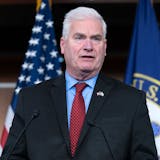In the Wirth Park offices of the Loppet Foundation — stewards of the city's annual midwinter ski fest — the staff is checking the weather forecasts "more than most anyone else on the planet," said operations director Mike Erickson. "At different times I've had six weather apps on my phone, hoping one of them will have good news."
So far, the news is not good. At least not for cross-country skiers.
What climatologists are calling the "Godzilla of all El Niños" is coming.
The federal Climate Prediction Center is claiming a 95 percent certainty of El Niño conditions through the spring. Some forecasters say it could be the most intense El Niño ever recorded. For the Upper Midwest, El Niño winters tend to be drier and milder, essentially turning Minnesota into southern Illinois for a season.
El Niño is that occasional meteorological event in which higher than usual sea-surface temperatures in the Pacific Ocean bump the jet stream farther north, scrambling the world's weather in wildly varying and dramatic ways. In a typical El Niño winter, Minnesota winters might be drier, while California is usually wetter, raising hopes that this winter will refill its reservoirs. Central Europe could freeze solid.
Climatologists' forecasts are complicated this year because in addition to a Godzilla-sized El Niño, they are wrestling with what they are calling the Blob — a mass of warm water in the northern Pacific that could intensify El Niño's impact. Could "Pacific decadal oscillation" (the Blob's technical name) become a household term like polar vortex?
"No question this could be one of the big ones," said Peter Boulay, a Minnesota state climatologist. "Not only is it coming, it's already here."
In the previous big El Niño, in the winter of 1997-98, Minnesota's winter was significantly warmer than usual (9.8 degrees above normal) and moderately drier (with nearly 10 fewer inches of snow than normal). The 1957-58 El Niño produced the driest winter on record in Minnesota, 33 fewer inches of snow.

